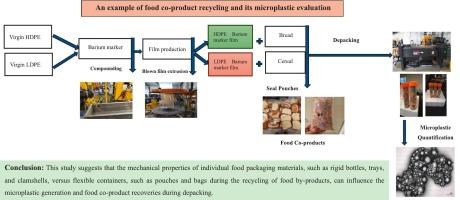Microplastic residue in recycled food co-products from mechanical depacking systems: a simulation study for animal food
IF 7.1
2区 环境科学与生态学
Q1 ENGINEERING, ENVIRONMENTAL
引用次数: 0
Abstract
This study is the first to determine the potential generation and transfer of microplastic (MP) into depacked food co-products from various food packaging using a commercial depacking system. Barium sulfate (BaSO4, 564 ± 108 nm) was dispersed into four polymer types, including low-density polyethylene (LDPE), high-density polyethylene (HDPE), polypropylene (PP), and polystyrene (PS). Polymers containing BaSO4 were converted into food packaging matching their traditional packaging. A depacker separated packaging from food co-products. Inductively coupled plasma-optical emission spectroscopy (ICP-OES) was applied to quantify BaSO4 as a MP indicator. Depacked foods were digested using an enzymatic approach to maintain the morphology of MPs then characterized using a 3D surface profiler. BaSO4 concentration in recovered food from HDPE, LDPE, and PP was below method limit of detection (≤290.65 ng BaSO4/g depacked food or ≤ 22.13 µg microplastic/g depacked food). The concentration in depacked food from PS was measured at 1278.65 ± 17.7 µg/g corresponding to low recovery of PS from the depacker. MPs were detected using 3D surface profiling in depacked food from PS after enzymatic digestion. Packaging waste mass recovery from depacking was significantly greater (p < 0.05) for film packaging materials than more rigid/brittle materials suggesting mechanical properties of packaging materials, such as rigid versus flexible containers, can influence MP generation and packaging recovery during depacking. This study also developed a novel method using barium-doped plastic to analyze the release of MPs from food co-products using ICP-OES.

机械脱包装系统回收食品副产品中的微塑料残留:动物食品的模拟研究
这项研究首次确定了微塑料(MP)的潜在产生和转移到使用商业脱包装系统的各种食品包装的脱包装食品副产品中。硫酸钡(BaSO4, 564±108 nm)分散成低密度聚乙烯(LDPE)、高密度聚乙烯(HDPE)、聚丙烯(PP)和聚苯乙烯(PS)四种聚合物。含有BaSO4的聚合物被转化为与传统包装相匹配的食品包装。分装员将包装与食品副产品分开。采用电感耦合等离子体发射光谱(ICP-OES)定量测定BaSO4作为MP指标。用酶的方法消化脱封的食物,以保持MPs的形态,然后用3D表面剖析仪进行表征。HDPE、LDPE、PP回收食品中BaSO4浓度均低于方法检出限(≤290.65 ng BaSO4/g脱包装食品或≤22.13µg微塑料/g脱包装食品)。PS脱封食品中PS的浓度为1278.65±17.7µg/g,说明该脱封食品中PS的回收率较低。在酶解后的PS脱壳食品中使用3D表面分析检测MPs。薄膜包装材料从拆封中回收的包装废弃物质量明显大于刚性/脆性材料(p < 0.05),这表明包装材料的机械性能,如刚性容器与柔性容器,会影响拆包装过程中MP的产生和包装的回收。本研究还开发了一种使用掺杂钡塑料的新方法,利用ICP-OES分析食品副产品中MPs的释放。
本文章由计算机程序翻译,如有差异,请以英文原文为准。
求助全文
约1分钟内获得全文
求助全文
来源期刊

Waste management
环境科学-工程:环境
CiteScore
15.60
自引率
6.20%
发文量
492
审稿时长
39 days
期刊介绍:
Waste Management is devoted to the presentation and discussion of information on solid wastes,it covers the entire lifecycle of solid. wastes.
Scope:
Addresses solid wastes in both industrialized and economically developing countries
Covers various types of solid wastes, including:
Municipal (e.g., residential, institutional, commercial, light industrial)
Agricultural
Special (e.g., C and D, healthcare, household hazardous wastes, sewage sludge)
 求助内容:
求助内容: 应助结果提醒方式:
应助结果提醒方式:


